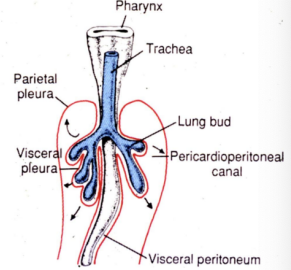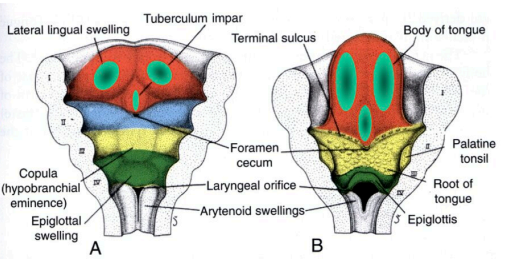Endoderm - Lung, Thymus, Thyroid, Tongue Development
Laryngeal Development (week 6-12)
The trachea is anterior to the esophagus. The mesoderm and neural crest cells become the supporting cartilage and muscle.
Week 6: Development of esophagobronchial septum and laryngotracheal orifice/laryngeal inlet
Week 7a: Proliferation of arches III/IV, creating the hypobranchial eminence (epiglottis)
Week 7b: Proliferation of arches IV/V/VI, creating the arytenoid swelling
Week 7c: Proliferation of the Primordial Glottis temporarily closes the Laryngeal orifice
Week 10: Proliferation of the hypobranchial eminence (epiglottis) while the primordial glottis lining undergoes apoptosis. This causes the laryngeal orifice to reopen and forms the primordial glottis
Vocab
- Larynx: Divides the throat into the esophagus and trachea
- Pharynx: Part of the throat immediately superior to the Larynx
- Laryngeal orifice: T-shaped opening, bordered by the primordial epiglottis superiorly

Innervation
- 10th cranial nerve: Musculature of the larynx
- Superior laryngeal nerve branch: Derivatives of the IV arch
- Recurrent laryngeal nerve branch: Derivatives of the VI arch
Lung development (week 5-12)
The lung buds appear off the trachea distally and secondary bronchial buds form from the original left and right buds. Three buds on the right, two on the left (to save space for the heart). Secondary buds become secondary bronchioles and branch into tertiary bronchioles (10 right, 8 left), forming the pericardioperitoneal canals which surrounds the heart.

Maturation of the lungs
Week 5-16 (Pseudoglandular)
- Formation of terminal bronchioles
- Formation of visceral and parietal pleura
Week 16-26 (Canalicular)
- Tertiary bronchioles divides into 2 respiratory bronchioles and 3-6 alveolar ducts
- Gas exchange can now occur, lungs are functional
Week 26-birth (Terminal sac)
- Formation of blood-air barrier with contact of terminal alveolar sacs with the capillary
- Formation of Type II alveolar epithelial cells (produce surfactant when born)
- Epithelial terminal alveolar sacs flatten out, increasing surface area
Birth-childhood
- Surfactant production (facilitates gas exchange)
- Differentiation of endothelial to epithelial cells
- Separation of pulmonary and systemic circulation
Tongue Development
BMP-7 from the endoderm inhibits cell proliferation while stimulating Noggin in the mesoderm. Patched (Ptc) is also secreted by the endoderm and stimulates growth. BMPs inhibit Ptc so Noggin is needed to turn down the BMP-7 and allow Ptc to stimulate tongue development.
The mesoderm is controlled by HOX targets from neural crest cells.
Red represents BMP-7, green represents Ptc.

Key Signaling Molecules
BMP-4
Secreted by distal endoderm. First in the endoderm lining the pharynx, causing growth of respiratory diverticulum and lung buds. We know this because BMP-4 is a promoter for LacZ and staining for LacZ reveals the locations of BMP-4 activity.
Noggin
Secreted by the Mesoderm (surrounds the distal endoderm) and inhibits ALL BMPs.
FGF10
Maintains the distal respiratory epithelium. May also help with branching.
Sonic Hedgehog (SHH)
If you knock it out, the lungs will underdevelop.
Interaction of BMP and noggin
BMP-7 from the endoderm inhibits proliferation while stimulating Noggin in the mesoderm. When BMP-4 is at high concentrations, Noggin is released, deactivating BMP-4. This allows for branching as the concentration gradient changes based on location.
Clinical pearls
Tracheoesophageal Fistulas (TEFs)
Commonly present as infant swallowing and spilling fluid into trachea, leading to coughing. These are part of a family of defects which often occur together.
VACTERL
- Vertebral anomalies
- Anal atresias
- Cardiac defects
- TEFs
- Esophageal atresias
- Renal anomalies
- Limb defects
Respiratory Distress Syndrome (RDS or Hyaline membrane Disease)
Responsible for 20% of premature infant deaths. Characterized by insufficient surfactant production from underdeveloped lungs and alveoli collapse from high surface tension. X-ray will look like broken glass.
Treated with Surfactant Replacement Therapy which is forced into the lungs or via a glucocorticoid treatment during pregnancy to accelerate surfactant production.
Oligohydramnios
When regions of the lung are not bathed in enough amniotic fluid. TEFs can cause oligohydramnios.
Congenital Lung Cysts
When larger bronchioles are dilated during development. These will drain poorly and can result in infections. Treatment involves insertion of a sponge with Bone Morphogenic Protein (BMP). Bone grows in the gap, fusing two vertebrae together.
Cystic Fibrosis
CFTR receptors will transport Cl out of the cell. This thins the mucus lining of the lungs. Mutation of CFTR will result in thick mucus and salty skin and generally requires a lung transplant.
CRISPR can be used to guide Cas-9 to the mutation site in cystic fibrosis and replace it with a functional sequence.